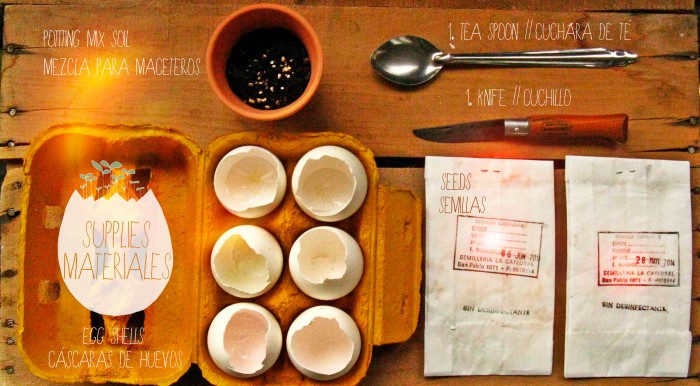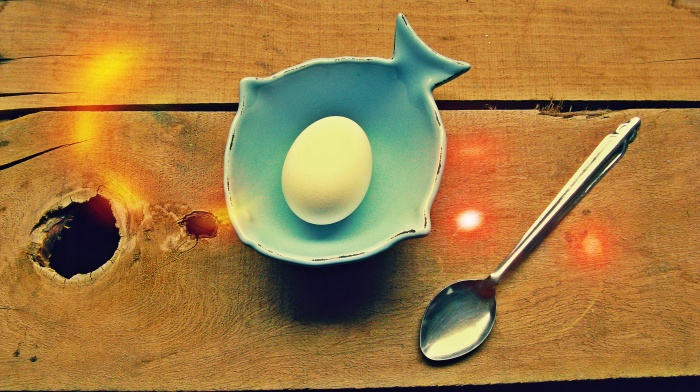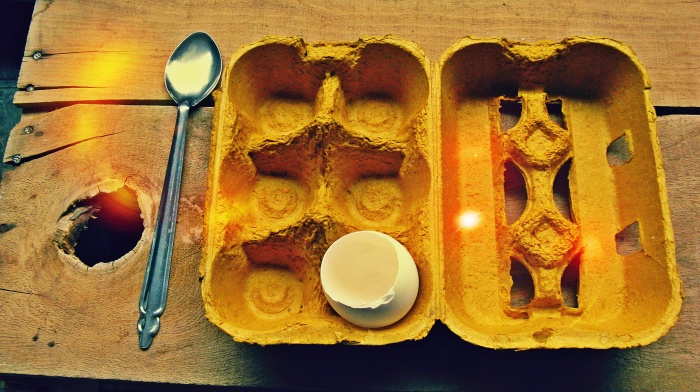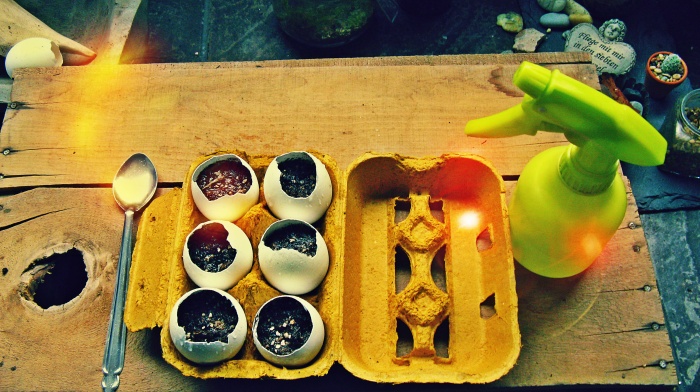
How to recycle egg shells?//¿Cómo reciclar las cáscaras de huevo?
If our personal diet includes eggs, I suggest a simple idea to recycle their egg shells before throwing them away. Consider these ideas of reusing the natural container in which our omelettes or scrambled eggs came.
The structure of the eggshells are composed of 93 to 97 percent calcium carbonate, in addition to nitrogen and phosphoric acid. These nutrients make egg shells an ideal option for use in our plants and garden as ferlizers.
Si nuestra alimentación personal contempla huevos, les sugiero una idea simple para reciclar sus cáscaras de huevo antes de tirarlas a la basura. Considera estas ideas de reutilizar el envase natural en el que vinieron nuestros omelettes o huevos revueltos.
La estructura de las cáscaras de huevo se componen de 93 a 97 por ciento de carbonato de calcio, además de nitrógeno y ácido fosfórico. Estos nutrientes hacen de las cáscaras de huevo una opción ideal para el uso en nuestras plantas y jardín como ferlizantes.
Eco Egg//Eco Huevo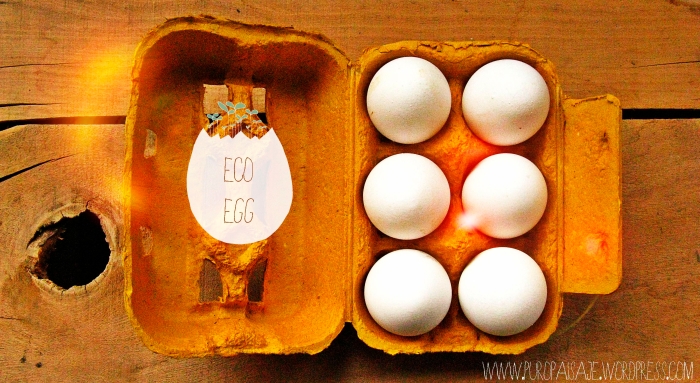
I have fallen in love with the idea of ecopot or eco eggs. It is a very simple idea to use empty egg shells as containers to germinate our vegetable, herbs and flowers seeds, with our seedlings * 100% organic and zero waste.
They are easy to made and will always take you a smile every time you see them! In addition, in a couple of months, we will be able to bring the spring and brighten the interior of our home or our workspace!
So the next time we use eggs remember to break the shell carefully and save them, so that in 8 to 10 weeks … Voila our plants ready to be transplanted!
* SEEDLING: CONTAINER, PLASTIC BAG, BOX, ETC., WHERE GERMINATION AND GROWTH OF SEEDS IS PERFORMED.
Me he enamorado de la idea de ecopot o eco huevos. Es una idea muy simple usar cáscaras de huevo vacías como recipientes para germinar nuestras semillas de vegetales, hierbas y flores, con nuestras plántulas * 100% orgánico y cero desperdicio.
¡Son fáciles de hacer y siempre te harán sonreír cada vez que los veas! Además, en un par de meses, podremos cerrar la primavera e iluminar el interior de nuestra casa o nuestro espacio de trabajo.
Entonces, la próxima vez que usemos huevos, recuerde romper el caparazón con cuidado y guardarlos, para que en 8 a 10 semanas … ¡nuestras plantas estén listas para ser transplantadas!
*SEMILLEROS: RECIPIENTE, BOLSA PLÁSTICA, CAJA, ETC, DONDE GERMINAN Y CRECEN SEMILLAS.
Supplies// Materiales
Dozen or half a dozen eggs (save the container in which they come)
1 Knife or something to gently tap the eggs
1 Tea Spoon
500 gr. Mixture of soil for nurseries or soil from pots.
Plant seeds, here depend if you want a floral or gourmet touch or both!
Docena o media docena de huevos (guardar el envase en que vienen).
1 Cuchillo o algo para golpear suavemente los huevos.
1 Cuchara de Té.
500 gr. Mezcla de suelo para almácigos o Tierra de maceteros.
Semillas de plantas, aquí dependerá si quieren un toque floral o gourmet o los dos!
step by step// paso a paso
Step 1: First of all, we have to empty the eggshell.
Paso 1: Antes que nada, tenemos que vaciar la cáscara de huevo.
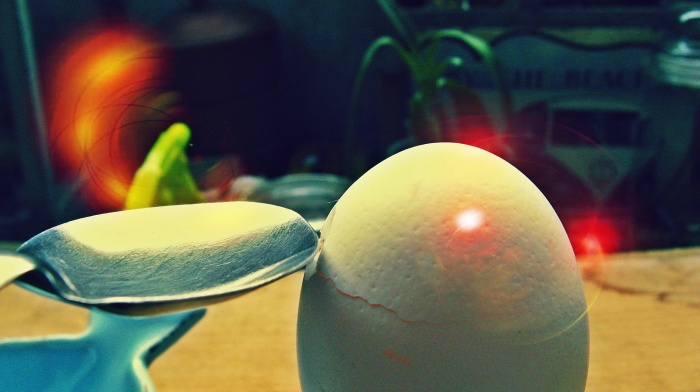 Step 2: We must be careful how we break the eggs. We need used a knife or a spoon to gently hit our eggs, when the shell breaks with our fingers removed the top of the shell.
Step 2: We must be careful how we break the eggs. We need used a knife or a spoon to gently hit our eggs, when the shell breaks with our fingers removed the top of the shell.
Paso 2: Necesitamos utilizar un cuchillo o una cuchara para golpear suavemente nuestros huevos, cuando el caparazón se rompe con nuestros dedos retiramos la parte superior de la cáscara.
Step 3: Once empty, the eggshells should be washed and left to dry. Then you can put it in the same package that came to be used as our base to contain our eco eggs.
Paso 3: Una vez vacías, las cáscaras de huevo deben lavarse y dejarse secar. Luego puede ponerlo en el mismo paquete que llegó a usarse como nuestra base para contener nuestros eco huevos.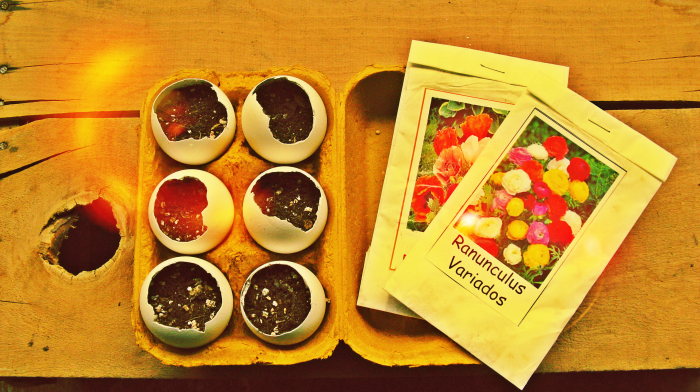
Step 4: The tea spoon is a perfect measure to add the potting mix inside the eggshell, we will fill it leaving between 1 and 2 cm. at the edge of the eggshell for watering the seeds.
Paso 4: La cuchara de té es una medida perfecta para agregar la mezcla al interior de la cáscara de huevo, dejando entre 1 y 2 cm. en el borde de la cáscara de huevo para regar las semillas.
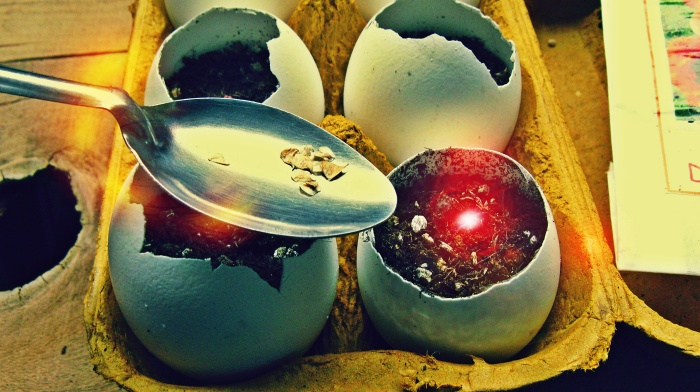 Step 5: Each ecological egg can have different varieties of seeds or just one type, as a recommendation, it is better not to place more than 3 seeds per ecological egg to allow them to grow without competition. Place the seeds then cover with a little soil and finish watering.
Step 5: Each ecological egg can have different varieties of seeds or just one type, as a recommendation, it is better not to place more than 3 seeds per ecological egg to allow them to grow without competition. Place the seeds then cover with a little soil and finish watering.
It is very important to clarify that these eco eggs are seedbeds, therefore, when the plants already have between 4 and 5 real leaves It is time to plant in the soil or final pot. At the time of taking them; Slightly crush the egg shell with your hand and gently plant in the ground our new plant, always making a small pressure on the ground at the end.
Paso 5: Cada huevo ecológico puede tener diferentes variedades de semillas o solo un tipo, como recomendación, es mejor no colocar más de 3 semillas por huevo ecológico para permitir que crezcan sin competencia. Colocar las semillas luego cubrir con un poco de tierra y terminar regando.
Es muy importante aclarar que estos eco eggs son semilleros, por lo tanto, cuando las plantas ya tengan entre 4 y 5 hojas reales, Es hora de plantar en el suelo o en la maceta final. En el momento de tomarlos; Triture ligeramente la cáscara de huevo con la mano y suavemente planta en el suelo nuestra nueva planta, siempre haciendo una pequeña presión en el suelo al final.
Paso 6: To finish we need to place our eco eggs near a window where it can receive sunlight for at least 4 hours a day. The earth should always be kept moist, but never flooded. .
NOTE: If we count with a joy and help of young children for this project, let them inspire us with the design of the eco eggs. They can paint them or help write the name of the plant that springs up inside our eggs. to not forget that we plant!
Paso 6: Para terminar necesitamos colocar nuestros eco eggs cerca de una ventana donde pueda recibir luz solar durante al menos 4 horas al día. Se debe mantener siempre la tierra humeda, pero nunca inundada.
NOTA: Si contamos con la alegría y la ayuda de los niños pequeños para este proyecto, permítales inspirarnos con el diseño de los huevos ecológicos. Pueden pintarlos o ayudar a escribir el nombre de la planta que brota dentro de nuestros huevos.¡ para no olvidar que plantamos!
Deco eco eggs
Only as a fact about our consumption the US food industry. accumulates 150,000 tons of eggshell waste each year. Chicken egg shells, which are the main type of egg shell waste.
Solo como dato sobre nuestro consumo la industria de alimentos de EE.UU. acumula 150.000 toneladas de residuos de cáscara de huevo cada año. Cáscaras de huevo de pollo, que son el principal tipo de residuos de cáscara de huevo.
Fran♣
